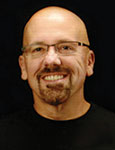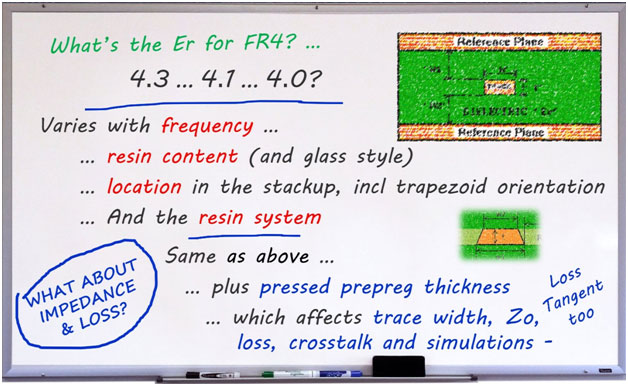 The genesis of a new column, and how the author came to write it.
The genesis of a new column, and how the author came to write it.
As I type this, I’m still considering about five column names. I have a lot to say about printed circuit materials, which I find super interesting, and all the candidates have the word “material” in them. Whatever appears at the top is what I ultimately chose. I will actually describe the decision process, because I think it’s interesting, but will first highlight the career journey that led me here.
Some 23 years ago, on Oct. 1, 1995, I joined the two HyperLynx founders as director of sales and marketing. I am a mechanical engineer by education. They explained digital signal integrity to me as analogous to the water-hammer effect – most easily described as the pipe-thumping (due to a pressure wave) heard in an old house when the water is turned on or off quickly. (“Ringing.”) I was relatively new to PCBs, but had a good background in fluids, having worked a good bit in “active” fluid-based electronic cooling up to that point.
A few months into the new gig, I stumbled into some of Lee Ritchey’s writings. It wasn’t hard. Lee’s work seemed to show up everywhere at that time. Classes at PCB West, PCB East, Printed Circuit Design, EE Times, EDN…. I became fascinated with how Lee seemed to be the only voice for how signal integrity – and dielectric constant and impedance – were impacted by material choices and frequency. In some ways, those were kind of like the Stone Age, as far as my understanding of materials, but I was intrigued. For years I heard engineers of all stripes talk about FR-4 this or FR-4 that. EDA software marketers too – and 99% of them still do. Lee was saying something you hear a lot these days from SI gurus, which is the electrical characteristics of a material depend on 1) the resin system, 2) the resin content, and 3) the signal frequency (or switching speed). Since then, I’ve read everything Lee has written on the subject. In fact, it’s amazing most SI authors have mostly left the subject alone. This, in fact, is part of my fascination with it.

Figure 1. Whiteboard discussion (no, not a real picture, but from Dilbert), circa 1997.
In roughly 2006, Isola approached Mentor Graphics to augment the HyperLynx Stackup Editor with more detailed material characteristics. EDA marketer that I was, I assigned the project to an excellent SI engineer I had hired from Dell’s SI group, but our software-development team was up to its ears developing solutions for DDRx, the burgeoning SERDES boom, and power integrity. You can only do so much. We shelved it. When I left Mentor, I doubled down on PCB material selection and stackup design, with an emphasis on signal integrity. These continue to be passions for me. My own software venture, Z-zero, was birthed out of this interest. The subject itself is like a wormhole. The deeper you go, the deeper it seems to get. I’m excited to write about it, and thankful for a forum like PCD&F to do so.
In 2015, Happy Holden and Clyde Coombs asked me to write a chapter on electrical and mechanical design parameters for the Printed Circuits Handbook. At the time, I was in the middle of a five-year stint in the laminate space, working for Nanya Plastics. Those five years helped me get a deeper appreciation and understanding of laminates. My experience crystallized the notion that, as I wrote in the chapter, “Everything that happens in the process of building a printed circuit board (PCB) that transmits signals from A to B and B to A works against signal quality. This is the underlying reason we spend so much time with ‘signal integrity.’ The electrical world and the physical world are fighting against each other.”
This is what this column is about, and I welcome your comments, input, insights and questions via email. I’m truly passionate about this subject, and probably have as many questions as I do answers, but I’ll research and seek to understand anything. It’s a deep, poorly understood subject.
Oh yeah … naming the column. Material World … Material Matters … Material Witness … Materialism … Materialistic. On some level, I liked all of these, so I had to come up with some weed-out heuristics. Material Witness sounds to me like a couple of suits at your door, so that’s definitely out. I like all the other names for various reasons. Material World is in a Madonna song, so it’s kind of trendy/cool. Material Matters ain’t bad … a name I could see engineers liking. Materialism – a philosophical position that contrasts with “idealism” – presents something of a double entendre that potentially works. Materialistic sounds cool because it sounds like “supercalifragilistic.” When I feel hemmed in, I sometimes consult the Google machine, which revealed the following:
- Material Matters: 389 million hits
- Materialism: 31.2 million hits
- Materialistic: 31.4 million hits
- Material World: 5.19 billion hits
Chicken dinner in the title.
Finally, I’m not very PC. Views in this column may or may not express the opinions of those who don’t currently work for themselves.
Bill Hargin has more than 20 years’ experience in PCB design software and materials. He is director of everything at Z-zero (z-zero.com); This email address is being protected from spambots. You need JavaScript enabled to view it..














